Nataraja
Nataraja (Tamil: நடராஜர்), (Sanskrit: नटराज, romanized: Naṭarāja) is a depiction of the Hindu god Shiva as the divine dancer. His dance is called Tandavam or Nadanta, depending on the context of the dance.[1][2] The pose and artwork is described in many Hindu texts such as the Anshumadbhed agama and Uttarakamika agama, the dance relief or idol featured in all major Hindu temples of Shaivism.[3]
| Nataraja | |
|---|---|
The Lord of the Dance | |
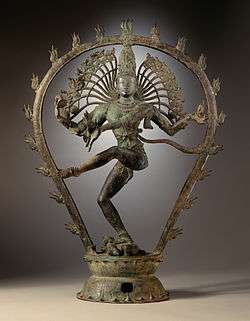 A 10th century Chola dynasty bronze sculpture of Shiva, the Lord of the Dance at the Los Angeles County Museum of Art | |
| Affiliation | Shiva |
| Symbols | Agni |
| Texts | Anshumadbhed agama Uttarakamika agama |
| Part of a series on |
| Shaivism |
|---|
 |
|
Scriptures and texts
|
|
Philosophy
|
|
Practices |
|
Schools
Saiddhantika Non - Saiddhantika
|
|
Related
|
The classical form of the depiction appears in stone reliefs, as at the Ellora Caves and the Badami Caves, by around the 6th century.[4][5] Around the 10th century, it emerged in Tamil Nadu in its mature and best-known expression in Chola bronzes, of various heights typically less than four feet,[6] some over.[7] The Nataraja reliefs have been identified in historic artwork from many parts of South Asia, in southeast Asia such as in Bali, Cambodia, and in central Asia.[8][9][10]
The sculpture is symbolic of Shiva as the lord of dance and dramatic arts,[8] with its style and proportions made according to Hindu texts on arts.[6] It typically shows Shiva dancing in one of the Natya Shastra poses, holding Agni (fire) in his left back hand, the front hand in gajahasta (elephant hand) or dandahasta (stick hand) mudra, the front right hand with a wrapped snake that is in abhaya (fear not) mudra while pointing to a Sutra text, and the back hand holding a musical instrument, usually a damaru.[6] His body, fingers, ankles, neck, face, head, ear lobes and dress are shown decorated with symbolic items, which vary with historic period and region.[1][11] He is surrounded by a ring of flames, standing on a lotus pedestal, lifting his left leg (or in rare cases, the right leg) and balancing / trampling upon a demon shown as a dwarf (Apasmara or Muyalaka[2]) who symbolizes ignorance.[6][12] The dynamism of the energetic dance is depicted with the whirling hair which spread out in thin strands as a fan behind his head.[13][14] The details in the Nataraja artwork have been variously interpreted by Indian scholars since the 12th century for its symbolic meaning and theological essence.[7][15]
Nataraja is a well known sculptural symbol in India and popularly used as a symbol of Indian culture,[16][17] in particular as one of the finest illustrations of Hindu art.[18][19]
Etymology
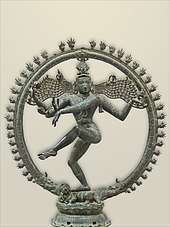
The word Nataraja is a Sanskrit term, from नट Nata meaning "act, drama, dance" and राज Raja meaning "king, lord"; it can be roughly translated as Lord of dance or King of dance.[20][21] According to Ananda Coomaraswamy, the name is related to Shiva's fame as the "Lord of Dancers" or "King of Actors".[15]
The form is known as Nataraja in Tamil Nadu and as Narteśvara or Nṛityeśvara in North India, with all three terms meaning "Lord of the dance".[22] Narteśvara stems from Nṛtta same as Nata which means "act, drama, dance" and Ishvara meaning "lord".[23] Natesa (IAST: Naṭeśa) is another alternate equivalent term for Nataraja found in 1st-millennium sculptures and archeological sites across the Indian subcontinent.[24]
Depiction
The dance of Shiva in Tillai, the traditional name for Chidambaram, forms the motif for all the depictions of Shiva as Nataraja. In Tamil, he is also known as “Sabesan” (Tamil: சபேசன்) which splits as “Sabayil aadum eesan” (Tamil: சபையில் ஆடும் ஈசன்) which means “The Lord who dances on the dais”. This form is present in most Shiva temples, and is the prime deity in the Nataraja Temple at Chidambaram.[25]
The two most common forms of Shiva's dance are the Lasya (the gentle form of dance), associated with the creation of the world, and the Tandava (the vigorous form of dance), associated with the destruction of weary worldviews—weary perspectives and lifestyles. In essence, the Lasya and the Tandava are just two aspects of Shiva’s nature; for he destroys in order to create, tearing down to build again.[26]
According to Alice Boner, the historic Nataraja artworks found in different parts of India are set in geometric patterns and along symmetric lines, particularly the satkona mandala (hexagram) that in the Indian tradition means the interdependence and fusion of masculine and feminine principles.[27] Nataraja is also shown with his wife Parvati as they dance together.
Characteristics
As the Lord of Dance, Nataraja, Shiva performs the Ananda Tandava (dance of bliss), the dance in which the universe is created, maintained, and dissolved. The symbolism in the art has been variously interpreted by scholars since the Chola empire era:[6][15][28]
- He dances within a circular or cyclically closed arch of flames (prabha mandala), which symbolically represent the cosmic fire that in Hindu cosmology creates everything and consumes everything, in cyclic existence or cycle of life. The fire also represents the evils, dangers, heat, warmth, light and joys of daily life. The arch of fire emerges from two makara (mythical water beasts) on each end.
- His legs are bent, which suggests an energetic dance. His long, matted tresses, are shown to be loose and flying out in thin strands during the dance, spread into a fan behind his head, because of the wildness and ecstasy of the dance.
- On his right side, meshed in with one of the flying strands of his hair near his forehead, is typically the river Ganges personified as a goddess, from the Hindu mythology where the danger of a mighty river is creatively tied to a calm river for the regeneration of life.
- His headdress often features a human skull (symbol of mortality), a crescent moon and a flower identified as that of the entheogenic plant Datura metel.
- The upper right hand holds a small drum shaped like an hourglass that is called a ḍamaru in Sanskrit.[29][30] A specific hand gesture (mudra) called ḍamaru-hasta (Sanskrit for "ḍamaru-hand") is used to hold the drum.[31] It symbolizes rhythm and time.
- The upper left hand contains Agni or fire, which signifies forces of creation and destruction. The opposing concepts show the counterpoise nature of life.
- A cobra uncoils from his lower right forearm, while his palm shows the Abhaya mudra (meaning fearlessness in Sanskrit), suggesting not to fear nearby evil, as well as evil and ignorance surrounding the devotee as he or she follows the righteousness of dharma.
- The lower left hand is bent downwards at the wrist with the palm facing inward, we also note that this arm crosses crosses Naṭarāja’s chest, concealing his heart from view. It represents tirodhāna, which means “occlusion, concealment.”
- The face shows two eyes plus a slightly open third on the forehead, which symbolize the triune in Shaivism. The eyes represent the sun, the moon and the third has been interpreted as the inner eye, or symbol of knowledge (jnana), urging the viewer to seek the inner wisdom, self-realization. The three eyes alternatively symbolize an equilibrium of the three Guṇas: Sattva, Rajas and Tamas.
- The dwarf upon whom Nataraja dances is the demon Apasmara purusha (Muyalaka, as he is known in Tamil), and who symbolises the demonic evil and ignorance over which the sacred dance of Shiva gives victory.
- The slightly smiling face of Shiva represents his calmness despite being immersed in the contrasting forces of universe and his energetic dance.[7]
The above interpretations of symbolism are largely based on historic Indian texts published in and after 12th-century, such as Unmai Vilakkam, Mummani Kovai, Tirukuttu Darshana and Tiruvatavurar Puranam.[15] Padma Kaimal questions some of these interpretations by referring to a 10th-century text and Nataraja icons, suggesting that the Nataraja statue may have symbolized different things to different people or in different contexts, such as Shiva being the lord of cremation or as an emblem of Chola dynasty.[32] In contrast, Sharada Srinivasan questions the link to Chola, and has presented archaeological evidence suggesting that Nataraja bronzes and dancing Shiva artwork in South India was a Pallava innovation, tracing back to 7th to 9th-centuries, and its symbolism should be pushed back by a few centuries.[33]
Significance
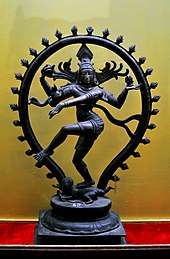
An essential significance of Shiva's dance at Tillai, the traditional name of Chidambaram, can be explained as:[34]
- First, it is seen as the image of his rhythmic or musical play which is the source of all movement within the universe. This is represented by the circular or elliptical frame surrounding Shiva.
- Secondly, the purpose of his dance is to release the souls of all men from the snare of illusion.
- Lastly, the place of the dance, Chidambaram, which is portrayed as the center of the universe, is actually within the heart.
Nataraja, states James Lochtefeld, symbolizes "the connection between religion and the arts", and it represents Shiva as the lord of dance, encompassing all "creation, destruction and all things in between".[35] The Nataraja iconography incorporates contrasting elements,[16] a fearless celebration of the joys of dance while being surrounded by fire, untouched by forces of ignorance and evil, signifying a spirituality that transcends all duality.[36]
Nataraja is a significant visual interpretation of Brahman and a dance posture of Shiva. The details in the Nataraja artwork has attracted commentaries and secondary literature such as poems detailing its theological significance.[7][15] It is one of the widely studied and supreme illustrations of Hindu art from the medieval era.[37][38]
History
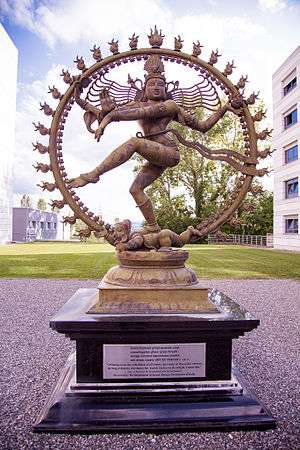
One of the earliest known Nataraja artworks has been found in the archaeological site at Asanapat village in Odisha, which includes an inscription, and is dated to about the 6th century CE.[39] The Asanapat inscription also mentions a Shiva temple in the Saivacaryas kingdom. Literary evidences shows that the bronze representation of Shiva's ananda-tandava appeared first in the Pallava period between 7th century and mid-9th centuries CE.[40]
Stone reliefs depicting the classical form of Nataraja are found in numerous cave temples of India, such as the Ellora Caves (Maharashtra), the Elephanta Caves, and the Badami Caves (Karnataka), by around the 6th century.[4][5] Archaeological discoveries have yielded a red Nataraja sandstone statue, from 9th to 10th century from Ujjain, Madhya Pradesh, now held at the Gwalior Archaeological Museum.[41][42] Similarly, Nataraja artwork has been found in archaeological sites in the Himalayan region such as Kashmir, albeit in with somewhat different dance pose and iconography, such as just two arms or with eight arms.[43] In medieval era artworks and texts on dancing Shiva found in Nepal, Assam and Bengal, he is sometimes shown as dancing on his vahana (animal vehicle) Nandi, the bull; further, he is regionally known as Narteshvara.[44] Nataraja artwork have also been discovered in Gujarat, Kerala and Andhra Pradesh.[45]
The oldest free-standing stone sculptures of Nataraja were built by Chola queen Sembiyan Mahadevi.[40] Nataraja gained special significance and became a symbol of royalty in Tamil Nadu. The dancing Shiva became a part of Chola era processions and religious festivals, a practice that continued thereafter.[46]
The depiction was informed of cosmic or metaphysical connotations is also argued on the basis of the testimony of the hymns of Tamil saints.[47]
The largest Nataraja statue is in Neyveli, in Tamil Nadu.[48]
In the contemporary Hindu culture of Bali in Indonesia, Siwa (Shiva) Nataraja is the god who created dance.[49] Siwa and his dance as Nataraja was also celebrated in the art of Java Indonesia when Hinduism thrived there, while in Cambodia he was referred to as Nrittesvara.[50]
In 2004, a 2m statue of the dancing Shiva was unveiled at CERN, the European Center for Research in Particle Physics in Geneva. The statue, symbolizing Shiva's cosmic dance of creation and destruction, was given to CERN by the Indian government to celebrate the research center's long association with India.[51] A special plaque next to the Shiva statue explains the significance of the metaphor of Shiva's cosmic dance with quotations from Fritjof Capra:
Hundreds of years ago, Indian artists created visual images of dancing Shivas in a beautiful series of bronzes. In our time, physicists have used the most advanced technology to portray the patterns of the cosmic dance. The metaphor of the cosmic dance thus unifies ancient mythology, religious art and modern physics.[52]
Though named "Nataraja bronzes" in Western literature, the Chola Nataraja artworks are mostly in copper, and a few are in brass, typically cast by the cire-perdue (lost-wax casting) process.[13]
Nataraja is celebrated in 108 poses of Bharatanatyam, with Sanskrit inscriptions from Natya Shastra, at the Nataraja temple in Chidambaram, Tamil Nadu, India.[1][3]
Gallery
_(14146091479).jpg) 6th/7th century Nataraja in Cave 1 of Badami cave temples
6th/7th century Nataraja in Cave 1 of Badami cave temples A damaged 6th-century Nataraja, Elephanta Caves[53]
A damaged 6th-century Nataraja, Elephanta Caves[53]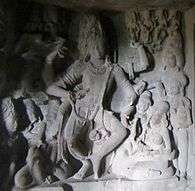 6th-century Nataraja in Cave 21, Ellora Caves[4]
6th-century Nataraja in Cave 21, Ellora Caves[4] 8th-century Nataraja in Kailasa temple (Cave 16), Ellora Caves
8th-century Nataraja in Kailasa temple (Cave 16), Ellora Caves 8th-century sandstone Nataraja from Madhya Pradesh
8th-century sandstone Nataraja from Madhya Pradesh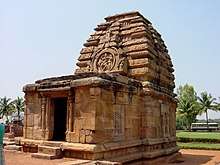 Sukanasa with Shiva Nataraja in Pattadakal
Sukanasa with Shiva Nataraja in Pattadakal- Shiva Nataraja, mid-10th Century AD, British Museum[54]
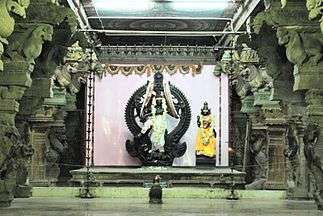 Shiva-Nataraja in the Thousand-Pillar-Hall of Meenakshi Temple in Madurai, Tamil Nadu, India
Shiva-Nataraja in the Thousand-Pillar-Hall of Meenakshi Temple in Madurai, Tamil Nadu, India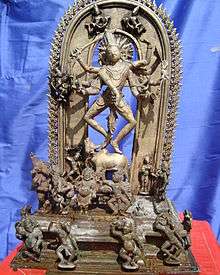 In the Shiva temple of Melakadambur is a rare Pala image that shows the ten-armed Nataraja dancing on his bull.
In the Shiva temple of Melakadambur is a rare Pala image that shows the ten-armed Nataraja dancing on his bull. Nataraja The Lord of Dance.
Nataraja The Lord of Dance.
In dance and yoga
In modern yoga as exercise, Natarajasana is a posture resembling Nataraja and named for him in the 20th century.[55] A similar pose appears in the classical Indian dance form Bharatanatyam.[56]
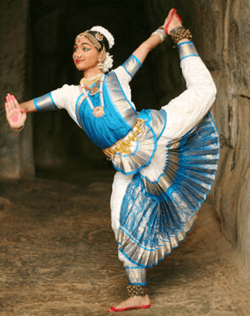 Nataraja pose in Bharatanatyam classical Indian dance
Nataraja pose in Bharatanatyam classical Indian dance Natarajasana in modern yoga as exercise
Natarajasana in modern yoga as exercise
References
- Archana Verma (2011). Performance and Culture: Narrative, Image and Enactment in India. Cambridge Scholars Publishing. pp. 19–26. ISBN 978-1-4438-2832-1.
- , Encyclopædia Britannica (2015)
- T. A. Gopinatha Rao (1997). Elements of Hindu Iconography. Motilal Banarsidass. pp. 223–224. ISBN 978-81-208-0877-5.
- James C. Harle (1994). The Art and Architecture of the Indian Subcontinent. Yale University Press. p. 126. ISBN 978-0-300-06217-5.
- Archana Verma (2012). Temple Imagery from Early Mediaeval Peninsular India. Ashgate Publishing. pp. 150–151. ISBN 978-1-4094-3029-2.
- T. A. Gopinatha Rao (1997). Elements of Hindu Iconography. Motilal Banarsidass. pp. 223–229, 237. ISBN 978-81-208-0877-5.
- James C. Harle (1994). The Art and Architecture of the Indian Subcontinent. Yale University Press. pp. 309–310. ISBN 978-0-300-06217-5.
- Saroj Panthey (1987). Iconography of Śiva in Pahāṛī Paintings. Mittal Publications. pp. 59–60, 88. ISBN 978-81-7099-016-1.
- Banerjee, P. (1969). "A Siva Icon from Piandjikent". Artibus Asiae. 31 (1): 73–80. doi:10.2307/3249451.
- Mahadev Chakravarti (1986). The Concept of Rudra-Śiva Through the Ages. Motilal Banarsidass. p. 178 with footnotes. ISBN 978-81-208-0053-3.
- T. A. Gopinatha Rao (1997). Elements of Hindu Iconography. Motilal Banarsidass. pp. 236–238, 247–258. ISBN 978-81-208-0877-5.
- Shiva as Lord of the Dance (Nataraja), Chola period, c. 10th/11th century The Art Institute of Chicago, United States
- Ananda Coomaraswamy (1922), Saiva Sculptures: Recent Acquisitions, Museum of Fine Arts Bulletin, Vol. 20, No. 118 (Apr., 1922), pages 18-19
- Gomathi Narayanan (1986), SHIVA NATARAJA AS A SYMBOL OF PARADOX, Journal of South Asian Literature, Vol. 21, No. 2, page 215
- The Dance of Shiva, Ananda Coomaraswamy
- Gomathi Narayanan (1986), SHIVA NATARAJA AS A SYMBOL OF PARADOX, Journal of South Asian Literature, Vol. 21, No. 2, pages 208-216
- Anna Libera Dallapiccola (2007). Indian Art in Detail. Harvard University Press. p. 28. ISBN 978-0-674-02691-9.
- David Smith (2003). The Dance of Siva: Religion, Art and Poetry in South India. Cambridge University Press. pp. 1–2. ISBN 978-0-521-52865-8.
- Frank Burch Brown (2014). The Oxford Handbook of Religion and the Arts. Oxford University Press. pp. 489–490. ISBN 978-0-19-517667-4.
- Coomaraswamy, Ananda K. (2013). The dance of Shiva. Rupa. p. 56. ISBN 978-8129120908.
- Stromer, Richard. "Shiva Nataraja: A Study in Myth, Iconography, and the Meaning of a Sacred Symbol" (PDF). Retrieved 10 March 2016.
- Los Angeles County Museum of Art; Pal, Pratapaditya (1986). Indian Sculpture: Circa 500 B.C.-A.D. 700. University of California Press. pp. 34–36, 138. ISBN 978-0520064775.
- Brunner-Lachaux, Hélène; Goodall, Dominic; Padoux, André (2007). Mélanges Tantriques À la Mémoire D'Hélène Brunner. Institut français de Pondichéry. p. 245. ISBN 978-2-85539-666-8.
- Stella Kramrisch (1981). Manifestations of Shiva. Philadelphia Museum of Art. pp. 43–45. ISBN 0-87633-039-1.
- Ananda Kentish Coomaraswamy, The Dance of Siva: Fourteen Indian Essays, (New York, The Sun wise Turn, 1918), p. 58. Internet Archive.
- Carmel Berkson, Wendy Doniger, George Michell, Elephanta: The Cave of Shiva, (Princeton: Princeton University Press, 1983). ISBN 0691040095
- Alice Boner (1990). Principles of Composition in Hindu Sculpture: Cave Temple Period. Motilal Banarsidass. pp. 163–164, 257. ISBN 978-81-208-0705-1.
- Shiva Nataraja, lord of the dance Encyclopedia of Ancient History (2013)
- Alice Boner; Sadāśiva Rath Śarmā (1966). Silpa Prakasa Medieval Orissan Sanskrit Text on Temple Architecture. Brill Archive. pp. xxxvi, 144.
- For the damaru drum as one of the attributes of Shiva in his dancing representation see: Jansen, page 44.
- Jansen, page 25.
- Padma Kaimal (1999), Shiva Nataraja: Shifting Meanings of an Icon, The Art Bulletin Volume 81, Issue 3, pages 390-419
- Srinivasan, Sharada (2004). "Shiva as 'cosmic dancer': On Pallava origins for the Nataraja bronze". World Archaeology. 36 (3): 432–450. doi:10.1080/1468936042000282726821.
- Ananda Kentish Coomaraswamy, The Dance of Śiva: Fourteen Indian Essays New York, The Sun wise Turn (1918), p. 58. Internet Archive.
- James G. Lochtefeld (2002). The Illustrated Encyclopedia of Hinduism: A-M. The Rosen Publishing Group. pp. 147, entry for Chidambaram. ISBN 978-0-8239-3179-8.
- James G. Lochtefeld (2002). The Illustrated Encyclopedia of Hinduism: N-Z. The Rosen Publishing Group. pp. 464–466. ISBN 978-0-8239-3180-4.
- David Smith (2003). The Dance of Siva: Religion, Art and Poetry in South India. Cambridge University Press. pp. 1–4. ISBN 978-0-521-52865-8.
- Roy C. Craven (1976). A concise history of Indian art. Praeger. pp. 144–147, 160–161. ISBN 978-0-275-22950-4.
- Rupendra Chattopadhya et al (2013), The Kingdom of the Saivacaryas, Berlin Indological Studies, volume 21, page 200; Archive
- Singh, Upinder (2008). A History of Ancient and Early Medieval India: From the Stone Age to the 12th Century. Pearson Education India. p. 642. ISBN 9788131711200.
- C Yamamoto (1971), Catalogue of Antiquities from East Asia, Vol. 1971, No. 96, pages L74-L92
- James C. Harle (1994). The Art and Architecture of the Indian Subcontinent. Yale University Press. pp. 156–157. ISBN 978-0-300-06217-5.
- Anne-Marie Gaston (1982). Śiva in dance, myth, and iconography. Oxford University Press. pp. 56, 47, 101.
- Anne-Marie Gaston (1982). Śiva in dance, myth, and iconography. Oxford University Press. pp. 130, 57.
- Anne-Marie Gaston (1982). Śiva in dance, myth, and iconography. Oxford University Press. pp. 48–50.
- Aghoraśivācārya; Richard H. Davis (2010). A Priest's Guide for the Great Festival. Oxford University Press. pp. 15–20, 24–25. ISBN 978-0-19-537852-8.
- Sharada Srinivasan, "Shiva as 'cosmic dancer': on Pallava origins for the Nataraja bronze", World Archaeology (2004) 36(3), pages 432–450.
- "Neyveli - Natarajar Temple". Vel Murugan. 20 January 2015. Retrieved 10 April 2020.
- Fredrik Eugene DeBoer; I Made Bandem (1995). Balinese Dance in Transition: Kaja and Kelod. Oxford University Press. pp. ii–iii. ISBN 978-967-65-3071-4.
- Alessandra Iyer (1998). Prambanan: Sculpture and Dance in Ancient Java : a Study in Dance Iconography. White Lotus. pp. 69–70. ISBN 978-974-8434-12-4.
- "Faces and Places (page 3)". CERN Courier. Archived from the original on 6 June 2018. Retrieved 30 January 2017.
- "Shiva's Cosmic Dance at CERN | Fritjof Capra". fritjofcapra.net. Retrieved 30 January 2017.
- James C. Harle (1994). The Art and Architecture of the Indian Subcontinent. Yale University Press. p. 123. ISBN 978-0-300-06217-5.
- British Museum Collection
- Iyengar, B. K. S. (1979) [1966]. Light on Yoga: Yoga Dipika. Thorsons. pp. 419–422. ISBN 978-1855381667.
- Bhavanani, Ananda Balayogi; Bhavanani, Devasena (2001). "BHARATANATYAM AND YOGA". Archived from the original on 23 October 2006.
He also points out that these [Bharatanatyam dance] stances are very similar to Yoga Asanas, and in the Gopuram walls at Chidambaram, at least twenty different classical Yoga Asanas are depicted by the dancers, including Dhanurasana, Chakrasana, Vrikshasana, Natarajasana, Trivikramasana, Ananda Tandavasana, Padmasana, Siddhasana, Kaka Asana, Vrishchikasana and others.
Further reading
- Ananda Coomaraswamy (1957). The Dance of Śiva: Fourteen Indian Essays. Sunwise Turn. OCLC 2155403.
- Jansen, Eva Rudy (1993). The Book of Hindu Imagery. Havelte, Holland: Binkey Kok Publications BV. ISBN 90-74597-07-6.
- Vivek Nanda; George Michell (2004). Chidambaram: Home of Nataraja. Marg Publications. ISBN 978-81-85026-64-0. OCLC 56598256.
- C Sivaramamurti (1974). Nataraja in Art, Thought, and Literature. National Museum. ISBN 978-81-230-0092-3. OCLC 1501803.
- David Smith (2003). The Dance of Siva: Religion, Art and Poetry in South India. Cambridge University Press. ISBN 978-0-521-52865-8.
External links
- Śiva's Dance: Iconography and Dance Practice in South and Southeast Asia, Alessandra Iyer (2000), Music in Art
- Shiva Nataraja Iconography, Freer Sackler Gallery, Smithsonian
- Nataraja: India's Cycle of Fire, Stephen Pyne (1994)
- Chidambareswarar Nataraja Temple
- Nataraja Image Archive
